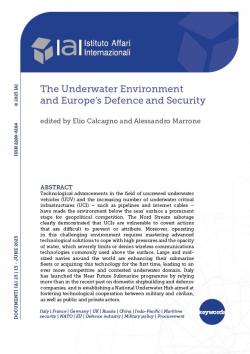The Underwater Environment and Europe’s Defence and Security
Technological advancements in the field of uncrewed underwater vehicles (UUV) and the increasing number of underwater critical infrastructures (UCI) – such as pipelines and internet cables – have made the environment below the seas’ surface a prominent stage for geopolitical competition. The Nord Stream sabotage clearly demonstrated that UCIs are vulnerable to covert actions that are difficult to prevent or attribute. Moreover, operating in this challenging environment requires mastering advanced technological solutions to cope with high pressures and the opacity of water, which severely limits or denies wireless communications technologies commonly used above the surface. Large and mid-sized navies around the world are enhancing their submarine fleets or acquiring this technology for the first time, leading to an ever more competitive and contested underwater domain. Italy has launched the Near Future Submarine programme by relying more than in the recent past on domestic shipbuilding and defence companies, and is establishing a National Underwater Hub aimed at fostering technological cooperation between military and civilian, as well as public and private actors.
-
Details
Rome, IAI, June 2023, 79 p. -
In:
-
Issue
23|13
Executive summary
1. The underwater domain, by Elio Calcagno
1.1 The technological challenges of underwater operations and seabed warfare
1.2 Submarine cables and pipelines: the world’s neurovascular system
1.3 Protecting underwater critical infrastructure
1.4 The renaissance of submarines
2. Uncrewed underwater vehicles: Opportunities and challenges, by Michelangelo Freyrie
2.1 Technological innovation
2.2 Operational perspectives
2.3 Examples of UUV adoption and development
3. An overview of the European context, by Michelangelo Freyrie
3.1 United Kingdom
3.2 France
3.3 Sweden
3.4 Spain
3.5 European and transatlantic cooperation
4. Germany, by Michelangelo Freyrie
4.1 Nord Stream sabotage as a wakeup call
4.2 Submarine fleet and projected upgrades
4.3 UUV capabilities and outlook
4.4 Germany’s conventional submarine production
5. The Indo-Pacific and the underwater environment, by Elio Calcagno
5.1 China: An underwater power in the making
5.2 South Korea and Japan
5.2.1 Submarine capabilities
5.2.2 Seabed warfare and UUVs3
5.3 Australia and the strategic implications of AUKUS
5.4 A growing submarine market in Southeast Asia
6. The Italian approach to the underwater domain, by Elio Calcagno and Alessandro Marrone
6.1 A country projected onto the sea and the need of a whole-of-government approach
6.2 More critical and more vulnerable infrastructures to protect
6.3 The underwater operational domain and situational awareness
6.4 The national innovation hub for the underwater domain
6.5 New Italian submarines and the teaming with uncrewed capabilities
7. Italy’s underwater technological and industrial capabilities, by Michele Cosentino
7.1 The U212 NFS programme: the industrial context
7.2 The Italian industrial and technological landscape
7.3 Funding the underwater domain
7.4 Industrial contributions from abroad
8. Conclusions, by Alessandro Marrone and Michele Nones
8.1 Critical infrastructures: a public-private partnership
8.2 Submarines: managing industrial competition and military cooperation
8.3 UUVs: European cooperation and a novel approach
8.4 The challenges and opportunities of dual-use technology
8.5 Six key points for Italy
Annex
Acronyms
Topic
Tag
Related content
-
Event24/05/2023
L’Italia, il Mediterraneo allargato e il dominio subacqueo
leggi tutto



